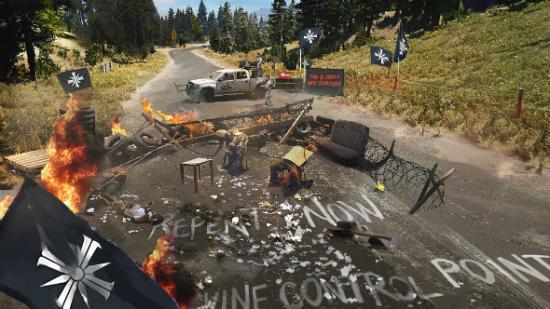There is something inescapably eerie about the setup for Far Cry 5 – nothing concrete, but a pervading sense that things are not quite right in this world. The game broaches some of the most searing topics of our current zeitgeist: gun control, religious extremism, and cults of personality. In its nightmarish story of armed the-end-is-nigh cultists, who force their Old-Testament-bashing ways onto the people of Hope County, Montana, Far Cry 5 draws parallels to the real world that its creators did not expect when development started on the game in 2014.
After the release date, setting, and system requirements? Here is everything we know about Far Cry 5.
“We started building this game three years ago,” reflects Far Cry 5 director Dan Hay, “we could have never imagined, and to be honest I wouldn’t have wanted to… that in some ways, it’s echoing out in the real world.”
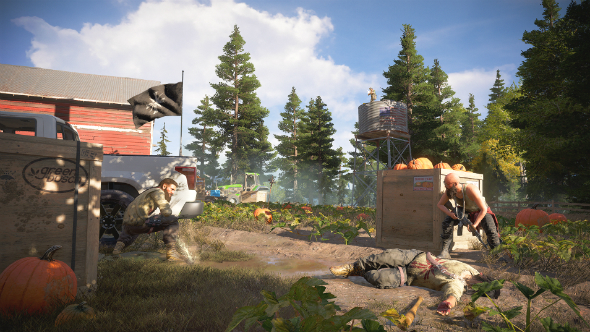
The white, male-dominated, fundamentalist cult taking centre stage in Far Cry 5’s marketing, surrounded by boxes of ammunition and semi-automatic rifles that can be bought legally in the United States, certainly cut close to the bone with events like the Unite the Right rally, Las Vegas shooting, and Sutherland Springs church shooting all fresh in our minds.
“Sometimes you’re working on a game with dragons or robots, and you go for a slice of pizza, you go for a break or a beer, and a lot of the conversations that you hear are completely different from what you’re making – that’s not the case with this game,” Hay tells us. “With this, you go out for a slice of pizza and it just feels like people know some of the different things that we are making. That is a strange feeling, and it’s why we build that separation, it’s why we make it ours, because it is a work of fiction.”
Far Cry has always been a series with just enough realism injected into its exotic settings and fantastical scenarios to come across as a remotely believable tale. The move to Montana is the closest Far Cry has ever been to home for the majority of its players but, for Hay, the Western setting is no different from an Indonesian island or Himalayan country. “Nobody saw Montana coming,” he says. “I vaguely remember the meeting where somebody put out the idea of Montana… and the response was, ‘Well, nobody knows anything about Montana, I don’t know anybody who’s been there’. I thought, ‘That sounds promising’. It’s super small, it’s remote, it’s a frontier, I never hear anything coming out of there – that sounds promising.
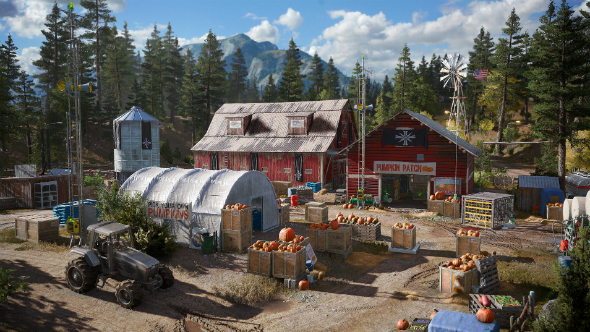
“So we got on a plane and we went there and we were like, ok, we understand: this is a place where people go to be alone, where they don’t want to be messed with. That sounds very Far Cry, so that’s what we did.”
Despite the real-world influences, Hope County is a manufactured setting, which is something Hay deems vital to the experience of Far Cry 5. “You can’t go to this place in the real world. What it does, is it creates some detachment, it creates a little bit of separation, which I think is a good thing,” Hay says “It makes it so that you can play the game and you can have an experience, enjoy all the different tones and things that are happening in the space – a conceivable space, but not necessarily a hyper-realistic version of today that’s ripped from the headlines.”
The same is true of The Project at Eden’s Gate, the doomsday cult who terrorise the inhabitants of Hope County in an effort to save as many souls as possible ahead of the rapture. Their leader, Joseph Seed – The Father to his followers – is an enigmatic megalomaniac who leads through violence and coercion. Visually, he bears a striking resemblance to David Koresh, the leader of the Branch Davidians who died alongside 81 of his followers during the Waco siege in 1993, with his tinted aviators and faded rock-star-cum-preacher style. Seed also shares Koresh’s obsession with weaponry, and the trailers depicting Eden’s Gate followers raising machine guns over their heads calls to mind the 46 automatic and 259 other firearms that were found at the Branch Davidians compound.
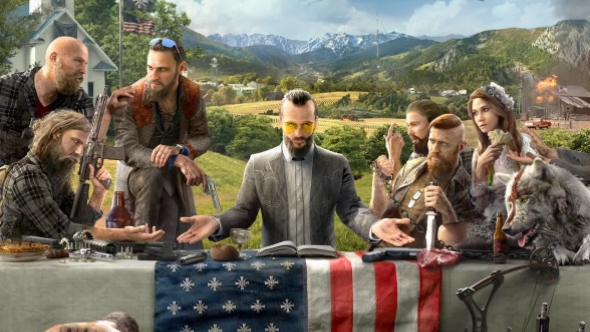
“I think the key for us is to make sure that we remember as we’re building it, that it is a game, it is a piece of entertainment,” Hay reflects. “We made our own cult, we made our own leader, you can’t meet these people in the real world.” But the team at Ubisoft Montreal hope to capture the magnetism of those leaders, not copy them into Far Cry 5 verbatim. “There’s no question that when you think about, historically, some of the people that have been magnetic and terrible leaders, those names [Charles Manson, David Koresh] pop up.”
Hay wants Eden’s Gate to draw us in, not just into the game’s world, but towards a realisation of how easily people can be taken in by cultist personalities. And not just others, but ourselves too – it’s a crucial part of what makes Far Cry 5 believable. “We did a lot of reading, we met with cult experts, but I think what people wrestle with is that the chances are a lot of us are not going to end up in a cult,” Hay says. “As a result, you end up having this outsider’s perspective of not believing that it is possible that you can be taken in, not believing that we can change our lives, give up our lives, and believe in somebody like that.”
With Far Cry’s pedigree of crafting captivating antagonists, Hay wanted to take things a step further with The Father. “What was really important for me was this idea of making a bad guy that was believable, who could deliver that little moment of magic where they could prove it to me, that if I sat down with him for five minutes, this guy could turn me and I would follow him.” It is Canadian film actor Greg Bryk who managed it: “we had been looking around for a while and testing different actors, and somebody called me over and said, ‘This is it’. So he shows his performance and within five minutes this chill goes down my back and I look at him and I realise that if this guy had a cult – the guy, the actor – chances are that he could win me over inside a week. It was chilling.”
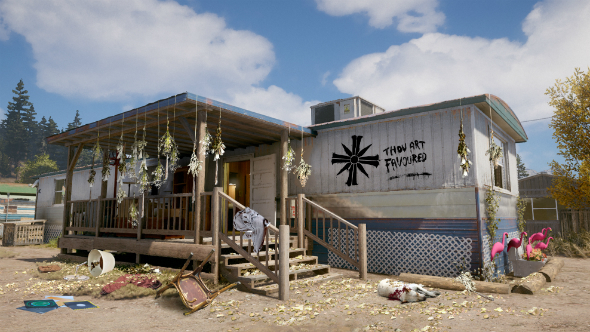
The Father and his armed apocalyptist acolytes are informed by the frontier setting of Hope County as much as they are a reflection of current world events. “For us, what we really focused on was the idea of this larger meta that seems to now be encompassing the globe now, which is that not everything feels right,” Hay says. “We made the choice to take that belief and put it to The Father, and say that he left to go to Montana because he looked up and had that same pang of worry. That helped us inform the location and the idea, so we then built our own cult around that, with the purpose of being able to say that it’s ours.”
That barrier between reality that fiction and invention provides is important for a game like Far Cry 5, which belongs to a series better known for putting us atop elephants and letting us charge through fortresses firing rockets than for its ability to deliver a political statement. Elements of real-world tensions inform a great deal of Far Cry 5’s location and characters, but it is not the whole story. “Those are the things that serve the spine of the game,” Hay insists, “but if you go out and explore all the things that the ‘anecdote factory’ has to offer and choose which parts of the game you want to snack on, in the end you author your own experience.”
Looking forward to Far Cry 5? Sound off in the comments below.
